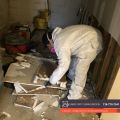
Introduction:
Mold, a ubiquitous presence in our environment, exists in various forms, and not all molds are created equal. While some molds play essential roles in nature, others can pose health risks when present indoors. In this article, we will explore the spectrum of mold types, distinguishing between the good, the bad, and the potentially toxic varieties. Additionally, we will emphasize the significance of mold inspection and testing services, drawing insights from the expertise of Bay Area Mold Pros.
The Good: Beneficial Molds:
- Penicillium:
Penicillium is a genus of molds known for its significant contributions to medicine. The antibiotic penicillin, derived from Penicillium mold, revolutionized the field of medicine by treating bacterial infections. In addition to its medical applications, Penicillium molds play a role in the production of certain cheeses.
- Aspergillus:
Aspergillus molds are versatile and can have both positive and negative impacts. Some species are used in the production of various fermented foods, such as soy sauce and miso. However, certain strains of Aspergillus can produce mycotoxins, posing health risks when present in high concentrations.
The Bad: Common Indoor Molds:
- Cladosporium:
Cladosporium is a mold commonly found both indoors and outdoors. While it is not typically toxic, it can trigger allergies and respiratory issues in sensitive individuals. Cladosporium often grows on damp surfaces, making it a common indoor presence in areas prone to moisture.
- Alternaria:
Alternaria is another mold commonly found in indoor environments, particularly in damp areas such as bathrooms and kitchens. Exposure to Alternaria spores can contribute to respiratory issues, especially in individuals with allergies or asthma.
- Stachybotrys chartarum (Black Mold):
Often referred to as black mold, Stachybotrys chartarum is a mold species that can produce mycotoxins. While the presence of black mold has gained notoriety, not all strains are toxic. However, exposure to mycotoxins can lead to health issues, making it essential to address the underlying moisture issues that support its growth.
The Toxic: Mycotoxin-Producing Molds:
- Aspergillus flavus:
Aspergillus flavus is known for producing aflatoxins, potent mycotoxins that can contaminate crops such as peanuts and grains. Aflatoxin exposure can pose severe health risks, including liver damage and an increased risk of certain cancers.
- Stachybotrys chartarum (Toxic Black Mold):
While not all black mold is toxic, certain strains of Stachybotrys chartarum can produce mycotoxins known as trichothecenes. Prolonged exposure to these mycotoxins can result in respiratory issues, skin irritation, and other health problems.
The Importance of Mold Inspection and Testing Services:
- Accurate Identification:
Professional mold inspection and testing services, such as those provided by Bay Area Mold Pros, are essential for accurately identifying mold types. Identifying the specific mold present allows for a targeted and effective remediation strategy.
- Assessing Mold Concentrations:
Mold testing helps assess the concentration of mold spores in the indoor environment. Elevated mold spore levels may indicate an active mold infestation, prompting the need for remediation to create a healthier indoor environment.
- Determining Health Risks:
Certain mold types, especially those that produce mycotoxins, can pose health risks. Mold testing services provides valuable information about the types and concentrations of mold present, aiding in the determination of potential health risks for occupants.
- Guiding Remediation Strategies:
Different mold types require specific remediation strategies. Professional mod inspection and testing services guide remediation efforts by providing insights into the extent of the infestation, the type of mold involved, and the underlying conditions supporting its growth.
Preventive Measures and Maintenance:
- Effective Moisture Control:
Preventing mold growth begins with effective moisture control. Regular inspections and maintenance to address water leaks, ventilation issues, and high humidity levels help create an environment less conducive to mold.
- Proactive Cleaning:
Regular cleaning and maintenance, especially in areas prone to dampness, can help prevent the growth of common indoor molds. Thorough cleaning reduces the likelihood of mold spores becoming airborne and causing respiratory issues.
- Education and Awareness:
Educating occupants about the signs of mold, proper ventilation practices, and the importance of reporting any water damage promptly fosters a culture of awareness. Early detection and intervention contribute to a healthier indoor environment.
Conclusion:
Understanding the spectrum of mold types – from beneficial to potentially toxic – is crucial for maintaining a safe and healthy indoor environment. Bay Area Mold Pros emphasizes the importance of professional mold inspection and testing services to accurately identify mold types, assess concentrations, and guide effective remediation strategies. By combining proactive preventive measures, regular maintenance, and professional intervention when needed, occupants can mitigate the risks associated with mold and foster a healthier living or working space.
Bayareamoldpros is a leading mold inspection and mold testing company providing quality mold analysis services and helping families & businesses overcome the devastating setbacks caused by mold. Visit our website bayareamoldpros.com either email us or fill in the contact form on our website.We can be reached 24/7 at (650)762-6228.




